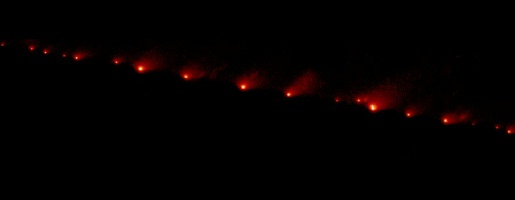 |
|||
|
The string of SL9 fragments on course for a collision
with Jupiter.
|
|||
| COMET SHOEMAKER-LEVY | |||
| The comet Shoemaker-Levy 9 (SL9) was discovered in March 1993 by Eugene and Carolyn Shoemaker, and David Levy. They made the discovery at Mount Palomar in California using a 0.46 metres Schmidt telescope, which was used to take stereo (3D) photographs. Another team confirmed the observation and saw that it comprised a string or train of objects moving together in a line. It was two months after the initial discovery that it was realised that they were all on collision course with Jupiter. | |||
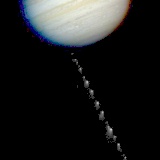 Composite Hubble Space Telescope imagery showing SL9 on its collision course to Jupiter. |
|||
| Unlike most comets, which orbit the Sun, SL9 found its way into a temporary path about Jupiter. Its closest approach was made on July 7th 1992 at a distance of 96,000 kilometres. This was the approach which tore it apart. Its furthest point from Jupiter was about 50 million kilometres. Its elongated orbit had an eccentricity of more than 0.999. It has been estimated that SL9 could have been in orbit around Jupiter for about 20 years. | |||
| Shoemaker-Levy 9 made history by being the first impact to be observed upon another body. As it was anticipated, SL9 was observed by a vast array of telescopes, including the Hubble Space Telescope and the Galileo spacecraft. The 1992 approach brought SL9 within the Roche limit, below which a body is broken up by gravitational forces. The comet SL9 was originally between 2 kilometres and 10 kilometres across. SL9 was torn into 21 or more fragments forming a string of debris stretched out over five million kilometres. The larger fragments were between 1 and 3 kilometres across. The 21 large pieces were assigned letters A to W. The letters I and O were not used. | |||
| Over 6 days, between 16th July and 22nd July 1994, they struck Jupiter. They all impacted on the dark side so the collision could not be observed directly. As predicted, they struck a point behind the edge of Jupiter's limb. About 30 to 40 minutes after each impact the impact sites crossed the morning terminator into daylight. | |||
| It was not known what might be seen of the impact. Would there be a fireball? Would the light from the blast reflect off the inner moons? Nor was it known what effect the impact would have on Jupiter, whether it would leave any visible sign. Many researchers thought that any trace of the impact would be minimal by the time the target site was visible on Earth. | |||
| The effect of each impact varied. The first fragment (A) created a bright blast and a plume rising 1000 kilometres above the clouds. The following fragments were similar and produced a small dark blemish on the surface. | |||
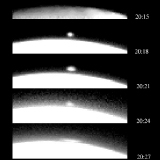 The sunlit plume rising from the fragment A impact site. |
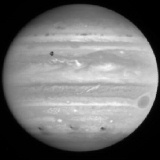 The dark impact sites of SL9 fragments A, C, and E. |
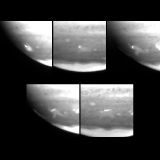 Time sequence showing the evolution of fragment A's impact site over 5 days. |
|
| The largest and most spectacular of the impacts was that of fragment G. It struck with the energy equivalent to six million megatons of TNT. The fireball, a hot dome of expanding gas, rose 3000 kilometres. It could be seen in visible light as well as infrared which most of the worlds observatories were using to monitor the collisions. | |||
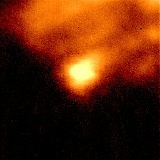 The violent explosion as fragment G impacts Jupiter, seen in infrared. |
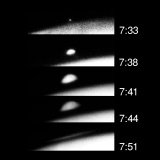 Time sequence of the G impact plume. |
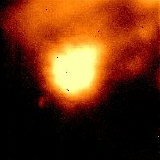 Fragment G's impact explosion outshines Jupiter at infrared wavelengths. |
|
| Fragment G left a big dark impact scar. Where fragments hit near earlier impacts, complex patterns developed. The smaller patches dissipated quite quickly but the larger markings (about 6000 kilometres across) persisted, later merging to form a dark band | |||
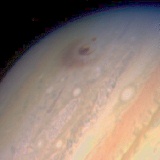 Hubble Space Telescope image of G's impact site. |
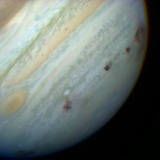 Dark smudges on Jupiter caused by the debris from the multiple impacts. |
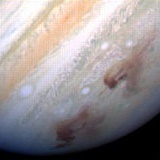 The evolution of the G impact site. |
|
| The patches which remained visible on the surface were analysed using spectroscopy, to determine their chemical make up. Broadly speaking, they contained material from the comet and from the upper layers of Jupiter. The analysis showed that the dark spots comprised a large assortment of elements - iron, silicon, manganese, sodium, sulphur, amongst others. They also held water molecules, ammonia and carbon dioxide, as well as organic compounds like methane, ethane and acetylene. | |||
| It was thought that the impacts would tell us a lot about the internal structure and composition of Jupiter. It is not known though how deep the fragments penetrated or whether they brought up material from particularly deep within the planet. Because the analysis showed that there was little water in the impact scars, it was presumed that the comets did not bring up deep material. It may be that there is simply less water than was anticipated at lower levels. | |||
| One of the best Hubble Space Telescope images captures the impression made by fragments D and G. The image shows a large sooty crescent about the same diameter as the Earth (12,000 kilometres). The crescent encircles a thin ring which in turn encloses a dense circular patch. This was made by fragment G. The small dense dark patch to the west of the ring was made by fragment D | |||
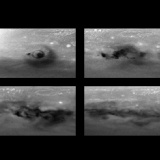 The impact sites of fragments D and G as observed by the Hubble Space Telescope. Hubble Space Telescope image of the impact sites of G and Q2. |
|||
| The central spot is where G entered Jupiter. The ring is thought to be caused by a shock wave, and the crescent by material from the fireball falling back down to the surface. Images acquired by Hubble over the weeks following the impact show the turbulent distortion of the site and the gradual formation of a dark band. | |||
 Hubble Space Telescope image of the impact sites of G and Q2. |
 Ultraviolet view of impact sites H, Q1, R, D, G, and the largest, L. |
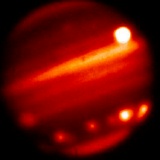 Top, Io, bottom, the bright R fragment impact site, in infrared. |
|
|
|
|||